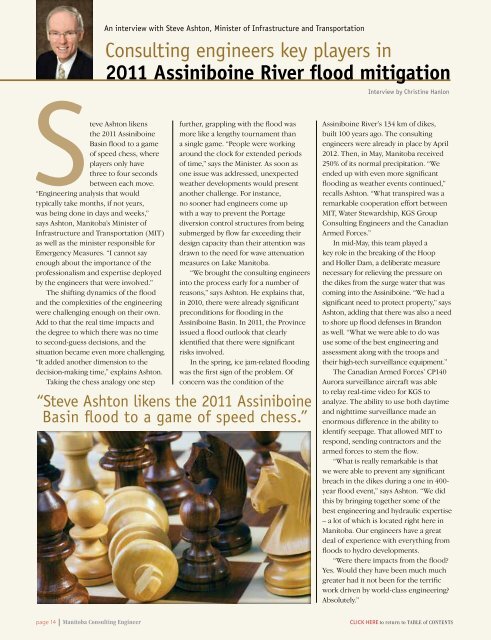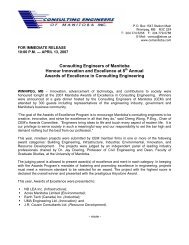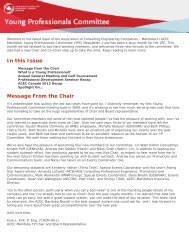Awards of Excellence - ACEC|Manitoba
Awards of Excellence - ACEC|Manitoba
Awards of Excellence - ACEC|Manitoba
Create successful ePaper yourself
Turn your PDF publications into a flip-book with our unique Google optimized e-Paper software.
An interview with Steve Ashton, Minister <strong>of</strong> Infrastructure and Transportation<br />
Consulting engineers key players in<br />
2011 Assiniboine River flood mitigation<br />
Interview by Christine Hanlon<br />
teve Ashton likens<br />
the 2011 Assiniboine<br />
Basin flood to a game<br />
<strong>of</strong> speed chess, where<br />
players only have<br />
three to four seconds<br />
between each move.<br />
“Engineering analysis that would<br />
typically take months, if not years,<br />
was being done in days and weeks,”<br />
says Ashton, Manitoba’s Minister <strong>of</strong><br />
Infrastructure and Transportation (MIT)<br />
as well as the minister responsible for<br />
Emergency Measures. “I cannot say<br />
enough about the importance <strong>of</strong> the<br />
pr<strong>of</strong>essionalism and expertise deployed<br />
by the engineers that were involved.”<br />
The shifting dynamics <strong>of</strong> the flood<br />
and the complexities <strong>of</strong> the engineering<br />
were challenging enough on their own.<br />
Add to that the real time impacts and<br />
the degree to which there was no time<br />
to second-guess decisions, and the<br />
situation became even more challenging.<br />
“It added another dimension to the<br />
decision-making time,” explains Ashton.<br />
Taking the chess analogy one step<br />
further, grappling with the flood was<br />
more like a lengthy tournament than<br />
a single game. “People were working<br />
around the clock for extended periods<br />
<strong>of</strong> time,” says the Minister. As soon as<br />
one issue was addressed, unexpected<br />
weather developments would present<br />
another challenge. For instance,<br />
no sooner had engineers come up<br />
with a way to prevent the Portage<br />
diversion control structures from being<br />
submerged by flow far exceeding their<br />
design capacity than their attention was<br />
drawn to the need for wave attenuation<br />
measures on Lake Manitoba.<br />
“We brought the consulting engineers<br />
into the process early for a number <strong>of</strong><br />
reasons,” says Ashton. He explains that,<br />
in 2010, there were already significant<br />
preconditions for flooding in the<br />
Assiniboine Basin. In 2011, the Province<br />
issued a flood outlook that clearly<br />
identified that there were significant<br />
risks involved.<br />
In the spring, ice jam-related flooding<br />
was the first sign <strong>of</strong> the problem. Of<br />
concern was the condition <strong>of</strong> the<br />
“Steve Ashton likens the 2011 Assiniboine<br />
Basin flood to a game <strong>of</strong> speed chess.”<br />
Assiniboine River’s 134 km <strong>of</strong> dikes,<br />
built 100 years ago. The consulting<br />
engineers were already in place by April<br />
2012. Then, in May, Manitoba received<br />
250% <strong>of</strong> its normal precipitation. “We<br />
ended up with even more significant<br />
flooding as weather events continued,”<br />
recalls Ashton. “What transpired was a<br />
remarkable cooperation effort between<br />
MIT, Water Stewardship, KGS Group<br />
Consulting Engineers and the Canadian<br />
Armed Forces.”<br />
In mid-May, this team played a<br />
key role in the breaking <strong>of</strong> the Hoop<br />
and Holler Dam, a deliberate measure<br />
necessary for relieving the pressure on<br />
the dikes from the surge water that was<br />
coming into the Assiniboine. “We had a<br />
significant need to protect property,” says<br />
Ashton, adding that there was also a need<br />
to shore up flood defenses in Brandon<br />
as well. “What we were able to do was<br />
use some <strong>of</strong> the best engineering and<br />
assessment along with the troops and<br />
their high-tech surveillance equipment.”<br />
The Canadian Armed Forces’ CP140<br />
Aurora surveillance aircraft was able<br />
to relay real-time video for KGS to<br />
analyze. The ability to use both daytime<br />
and nighttime surveillance made an<br />
enormous difference in the ability to<br />
identify seepage. That allowed MIT to<br />
respond, sending contractors and the<br />
armed forces to stem the flow.<br />
“What is really remarkable is that<br />
we were able to prevent any significant<br />
breach in the dikes during a one in 400-<br />
year flood event,” says Ashton. “We did<br />
this by bringing together some <strong>of</strong> the<br />
best engineering and hydraulic expertise<br />
– a lot <strong>of</strong> which is located right here in<br />
Manitoba. Our engineers have a great<br />
deal <strong>of</strong> experience with everything from<br />
floods to hydro developments.<br />
“Were there impacts from the flood?<br />
Yes. Would they have been much much<br />
greater had it not been for the terrific<br />
work driven by world-class engineering?<br />
Absolutely.”<br />
page 14 | Manitoba Consulting Engineer<br />
Click Here to return to Table <strong>of</strong> Contents











